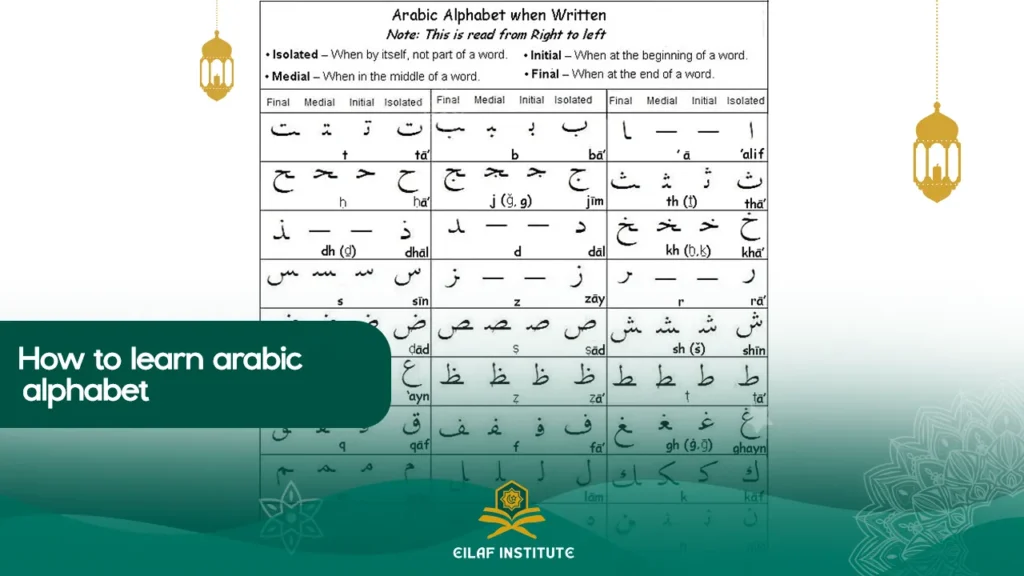The Arabic alphabet is just the first step, and, if done well, mastering the language should be one of the exciting moments to be experienced by one looking to learn something new. You can do the same by knowing the script’s origin, learning pronunciation and the way to write the letters, mastering the short vowels, and then practicing it. The mantras of regular practice are to listen to native speakers and to be patient in improving Arabic Reading, writing, and speaking.
Where did the Arabic alphabet come from?
The Arabic alphabet is derived from the Phoenician one; the latter was used around the 12th century BCE in the Mediterranean area and developed through various stages, influenced by Semitic languages and other scripts.
Origins in the Nabataean Script: Arabic script is a derivative of the Nabataean script, which was employed by the Nabataeans, an ancient Arab tribe inhabiting modern-day Jordan, Syria, and Saudi Arabia. The Nabataean script was adapted from the Aramaic script, which itself evolved from Phoenician.
Early Development: The earliest recorded forms of Arabic, in a script that was recognizable to today’s, took place in the 4th century CE. Those early forms were used by the Arab tribes in the Arabian Peninsula, and the alphabet slowly began to take the form it has today.
Standardization: The Arabic script started being standardized with the rise of Islam and proliferation of the Quran by the 7th century CE. This was to increase greatly because of the spread of Islam, as well as Arabic through the Middle East, North Africa, and beyond. This helped greatly in ensuring the Arabic alphabet became among the most utilized throughout the world.
Learning the Alphabet in Arabic
The Arabic alphabet consists of 28 letters and is written from right to left. Unlike alphabets in the Latin language, in Arabic, the shape of the letters changes depending on whether they are at the beginning, middle, or end of a word or when they are standing alone. Here are some basic characteristics of the Arabic alphabet:
Letters and Sounds: Every letter in the Arabic alphabet has a specific sound. Arabic has a lot of sounds that don’t exist in English; hence, pronunciation of each and every letter is necessary when learning.
Read also about : tips to Learn Arabic Language Quickly
Isolated and Connected Forms: Most letters in Arabic have four forms:
Isolated: This is when the letter is alone.
Initial: This is when the letter is at the beginning of a word.
Medial: This is when the letter is in the middle of a word.
Final: when the letter is at the end of a word.
Example:
The letter ب (Baa) in its isolated form is ب, in the initial form it’s بـ, in the medial form it’s ـبـ, and in the final form it’s ـب.
Arabic Short Vowels (Diacritics)
Besides the letters themselves, Arabic uses diacritical marks, or short vowels, above and/or below the letter to form vowel sounds. These short vowels are very important for the correct pronunciation, especially for beginners:
Fatha: A short “a” sound, placed above the letter.
Damma: A short “u” sound, placed above the letter.
Kasra: A short “i” sound, placed below the letter.
Arabic also uses sukun to indicate no vowel sound, and shadda to indicate doubling of a consonant.
Example: The letter ب with a Fatha is بـَ (“ba”). With a Kasra it is بِ (“bi”).
Note that these short vowels are usually not written in everyday texts like newspapers or novels, but used in religious texts like the Quran, or in beginner textbooks to guide learners in the correct pronunciation.
The Arabic Alphabet Has Some Foreign/Non-Native Letters Too
While most of the Arabic letters are native to the language, the script has adopted foreign letters to represent the sounds used in other languages. These letters have been included as Arabic spread to regions with diverse phonetic systems.
خ: This is a letter that represents a “kh” sound, like in “Bach” or “loch.”
پ: This letter represents the “p” sound and is commonly used in Persian, Urdu, and other languages.
چ (Cheh): Used in Persian and Urdu, representing the “ch” sound, as in “church”.
گ (Gaf): Used in languages such as Persian and Urdu, representing the “g” sound.
ڤ (Veh): It represents the “v” sound, used in Urdu and Persian.
These additional letters are not part of the traditional 28-letter Arabic alphabet but are used in languages that adapted Arabic script, such as Persian, Urdu, and Pashto.
Enhance Your Reading and Writing Skills in Arabic
Read also about : arabic phrases for travel
Practice regularly: Mastering the Arabic alphabet will require consistent practice.
Practice reading and writing Arabic letters and words every day, setting aside time for such activities. Flashcards: Use flashcards to learn the alphabet and practice identifying letters in their different forms. Websites like Anki or Quizlet allow you to either create your flashcards or use a pre-made set designed to learn Arabic.
Start with Simple Words: Once you’re familiar with the alphabet, begin reading simple words. Start with familiar words, such as common greetings (e.g., السلام عليكم, “As-salamu alaykum”) or easy nouns.
Focus on Writing: Practicing writing the Arabic script is essential to internalizing the shapes and connections of letters. Begin with isolated letters, then move on to practicing how letters connect in words.
Practice with Books and Apps: Beginners can use educational books like Alif Baa to learn Arabic. Many apps, like Duolingo, Rosetta Stone, or Memrise, also provide structured lessons on the Arabic alphabet and basic vocabulary.
Practicing Speaking Will Get You Used to the Sounds of Arabic
Arabic has a lot of unique sounds quite different from English and most other languages. The only way you will get used to the pronunciation is by practicing speaking Arabic as much as possible. Here’s how: Listen and Repeat: Listen to native speakers through YouTube videos, podcasts, or language learning apps. Repeat what you hear to mimic the pronunciation. Apps like Pimsleur and ArabicPod101 offer excellent audio-based learning experiences.
Arabic Language Exchange: Practice with native speakers through language exchange in Arabic. You can find a language partner via websites like HelloTalk and Tandem. You can chat with native speakers on those platforms and practice speaking with them.
Focus on Pronunciation: Pay special attention to the unique Arabic sounds, such as ع Ayn, غ Ghayn, and ق Qaaf. These sounds may not exist in your native language, so it’s important to practice them regularly.
Imitate Arabic TV or Movies: Listen to Arabic TV, movies, or news with subtitles; this will make you familiar with how it really sounds in a natural setting. Attempt to imitate some actors or hosts saying specific words.
The Arabic alphabet is just the first step, and, if done well, mastering the language should be one of the exciting moments to be experienced by one looking to learn something new. You can do the same by knowing the script’s origin, learning pronunciation and the way to write the letters, mastering the short vowels, and then practicing it. The mantras of regular practice are to listen to native speakers and to be patient in improving Arabic reading, writing, and speaking.Join Eilaf to be able to master the Arabic alphabet

